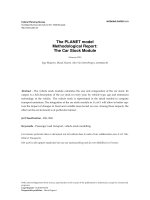The Mobile Station and the Subscriber Identity Module
Bạn đang xem bản rút gọn của tài liệu. Xem và tải ngay bản đầy đủ của tài liệu tại đây (181.16 KB, 6 trang )
2
The Mobile Station and the Subscriber
Identity Module
The GSM telephone set and the SIM are the only system elements with which
most users of GSM have direct contact. The GSM telephone set and the SIM
form an almost complete GSM system within themselves with all the function-
ality, from ciphering to the HLR. Figure 2.1 shows a block diagram of a mobile
station with a SIM slot.
2.1 Subscriber Identity Module
The SIM is a microchip that is planted on either a check card (ID-1 SIM) or a
plastic piece about 1 cm square (plug-in SIM). Figure 2.2 shows both variants.
Except for emergency calls, a GSM mobile phone cannot be used without the
SIM. The GSM terminology distinguishes between a mobile station and
mobile equipment. The mobile equipment becomes a mobile station when the
SIM is inserted. There is no difference in functionality between the ID-1 SIM
and the plug-in SIM, except for size, which is an advantage for the plug-in
SIM when used in a small handheld telephone. Today, many network opera-
tors offer (at an additional cost) identical pairs of ID-1 SIM/plug-in SIM, so
the same SIM can be used in a car phone and in a handheld telephone.
13
14GSMNetworks:Protocols,Terminology,andImplementation
Voice
encoding
> Channel encoding
> Interleaving
> Burst generation
Ciphering
Modulation
Amplifier
Voice
decoding
>
>
>
Channel Decoding
De-Interleaving
Re-formating
Deciphering
Demodul.
Central processor, clock and tone, internal bus system, keyboard (HMI)
SIM Subscriber Identity Module=
=>
=>
=>
=>
=>
Figure 2.1 Block diagram of a GSM MS.
2.1.1 The SIM as a Database
The major task of a SIM is to store data. That does not mean that the data
is only subscriber data. One has to differentiate between data types for vari-
ous tasks. The most important parameters that a SIM holds are presented in
Table 2.1. It should be noted that the list is not complete and that the SIM can
also be used to store, for example, telephone numbers.
2.1.2 Advantage for the Subscriber
The SIM is one of the most interesting features for a user of GSM, because it
permits separation of GSM telephone equipment and the related database. In
other words, the subscriber to a GSM system is not determined by the identity
of the mobile equipment but by the SIM, which always has to be inserted into
the equipment before it can be used. This is the basis for personal mobility.
The Mobile Station and the Subscriber Identity Module
15
GSM SIM
.
.
.
.
.
Plug-in SIM
ID-1 SIM
Figure 2.2 Plug-in SIM and ID-1 SIM.
Table 2.1
Data Stored on a SIM
Parameter Remarks
Administrative data
PIN/PIN2 (m/v) Personal identification number; requested at every powerup (PIN or PIN2)
PUK/PUK2 (m/f) PIN unblocking key; required to unlock a SIM
SIM service table (m/f) List of the optional functionality of the SIM
Last dialed number) (o/v) Redial
Charging meter (o/v) Charges and time increments can be set
Language (m/v) Determines the language for prompts by the mobile station
16 GSM Networks: Protocols, Terminology, and Implementation
Table 2.1 (continued)
Parameter Remarks
Security related data
Algorithm A3 and A8
(m/f)
Required for authentication and to determine Kc
Key Ki (m/f) Individual value; known only on SIM and the HLR
Key Kc (m/v) Result of A8, Ki, and random number (RAND)
CKSN (m/v) Ciphering key sequence number
Subscriber data
IMSI (m/f) International mobile subscriber identity
MSISDN (o/f) Mobile subscriber ISDN; directory number of a subscriber
Access control class(es)
(m/f)
For control of network access
Roaming data
TMSI (m/v) Temporary mobile subscriber identity
Value of T3212 (m/v) For location updating
Location updating status Is a location update required?
LAI (m/v) Location area information
Network color codes
(NCCs) of restricted
PLMNs (m/v)
Maximum of 4 PLMNs can be entered on a SIM after unsuccessful loca-
tion update; cause “PLMN not allowed.” Oldest entry deleted when more
than 4 restricted PLMNs are found.
NCCs of preferred
PLMNs (o/v)
What PLMN should the MS select, if there is more than one to choose
from and the home PLMN is not available?
PLMN data
NCC, mobile country
code (MCC), and mobile
network code (MNC) of
the home PLMN (m/f)
Network identifier
Absolute radio
frequency channel
numbers (ARFCNs) of
home PLMN (m/f)
Frequencies for which the home PLMN is licensed.
Legend: m = mandatory; o = optional; f = fixed, unchangeable value; v = changeable
Because of the SIM, a GSM customer can use different telephones (e.g., a
car phone and a handheld phone) and still be reachable under the same direc-
tory number. Even in case of a defect in the user’s GSM telephone, any other
GSM telephone can be used instead, simply by changing the SIM.
2.2 Mobile Station
A GSM terminal is, even for experts, a technical marvel. Consider the rate at
which prices have fallen, the complexity of the devices, and the large number of
different types of equipment available. All the functionality known from the
BTS transmitter/receiver (TRX), like Gaussian minimum shift keying (GMSK)
modulation/demodulation up to channel coding/decoding, also needs to be
implemented in an MS.
Other MS-specific functionalities need to be mentioned, like dual-tone
multifrequency (DTMF) generation and the most important issue, the eco-
nomical use of battery power.
From the perspective of the protocol, the MS is not only a peer of the
BTS but communicates directly with the MSC and the VLR, via the mobility
management (MM) and call control (CC). Furthermore, the MS has to be able
to provide a transparent interface (terminal adaptation function, or TAF) for
data and fax connections to external devices.
2.2.1 Types of Mobile Stations
The most common way to distinguish among GSM mobile equipment is by
the power class ratings, in which the value specifies the maximum transmission
power of an MS.
When GSM was introduced, five power classes were defined for
GSM 900, of which the most powerful class allowed for a 20W output. That
class is no longer supported; currently, the most powerful rating is 8W. The
power emission of DCS 1800 and PCS 1900 mobiles is generally lower.
The Glossary lists the power classes for all three standards.
2.2.2 Functionality
GSM Recommendation 02.07 describes in detail what functionality mobile
equipment has to support and what features are optional. The most important
and mandatory features are:
The Mobile Station and the Subscriber Identity Module
17









